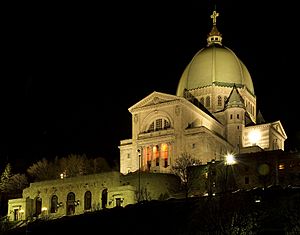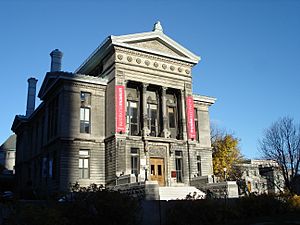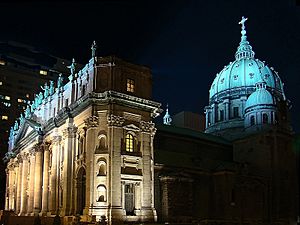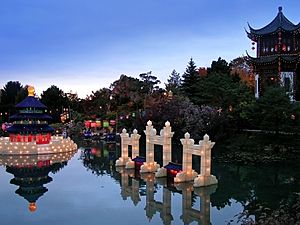Culture of Montreal facts for kids
Montreal is often called "Canada's Cultural Capital" because it's a super important city for arts and culture, especially for French-speaking productions. It's a big hub for French TV, radio, theater, movies, and books. The Quartier Latin area is full of lively cafés where you can feel this creative energy. Montreal's many different communities have also helped create its unique local culture.
As a North American city, Montreal shares a lot of cultural vibes with other big cities on the continent. It has amazing high culture, a long history of jazz and rock music, and exciting new ideas in art, theater, music, and dance. But because it mixes French and English traditions, Montreal has a truly special cultural identity in the world. Another cool thing about Montreal's culture is how lively its downtown area gets, especially in summer, with tons of festivals and events.
Contents
Arts and Performances in Montreal
Place des Arts: Montreal's Culture Hub
The Place des Arts is like the heart of classical art in Montreal. It's a big complex of concert and theater halls in downtown, surrounded by a large open square. It's also where many summer festivals happen! Inside, you'll find six amazing halls: Salle Wilfrid-Pelletier, Théâtre Maisonneuve, Théâtre Jean-Duceppe, Cinquième Salle, and Studio-Théâtre. There's also an outdoor space called l'Esplanade. You can watch classical dances, operas, plays, and music shows from all over the world, and from Montreal's own talented groups, almost every day. The Musée d'art contemporain (Museum of Contemporary Art) is right across from Place des Arts. Many important theater groups and music venues are nearby in what's now called the Quartier des Spectacles (Entertainment District).
Dance and Amazing Shows
Montreal is home to Les Grands Ballets Canadiens, a top ballet company that performs at Place des Arts. The city has also been a leader in modern dance since the 1980s. Famous dance groups like La La La Human Steps, O Vertigo, and the Fondation Jean-Pierre Perreault have traveled the world and even worked with famous artists on videos and concerts. These groups are known for mixing different art forms into their dances. This creative approach helped make the Cirque du Soleil super popular. Cirque du Soleil is a huge company that combines modern circus acts with amazing performances. The Agora de la danse is another place where you can often see contemporary dancers perform.
Classical Music in Montreal
The Montreal Symphony Orchestra (MSO) is based at Place des Arts and performs there regularly. The MSO is one of the best orchestras in North America, especially known for its performances of Maurice Ravel's music. Since 2006, the American conductor Kent Nagano has led the MSO.
Two other popular Montreal orchestras that often perform at Place des Arts are the Orchestre Métropolitain, led by Yannick Nézet-Séguin, and I Musici de Montréal. I Musici de Montréal is a chamber orchestra founded by Yuli Turovsky and led by Jean-Marie Zeitouni since 2011. They are considered amazing at playing the music of George Frideric Handel. Place des Arts is also home to the Opéra de Montréal, which is Montreal's most famous opera company. There's even a Montreal radio station just for classical music!
Montreal's Lively Music Scene
Since most people in Montreal speak French, many popular local bands and singers perform in French. In the past, French-speaking artists like Beau Dommage, Offenbach, and Cowboys Fringants could fill huge arenas. Some, like Diane Dufresne, even performed at the Olympic Stadium! Special events, like the music show for Quebec's national holiday, often attract over 100,000 people. The biggest event for French music is the Francofolies festival, which happens every year. It brings together artists from French-speaking countries around the world, popular Quebec artists, and new talents.
Montreal's English-speaking music scene is also getting a lot of attention worldwide. The success of many current artists and bands, like Arcade Fire, is partly thanks to the city's culture of mixing different music styles from various cultures. Many music festivals and independent record labels also help these artists succeed. Other well-known Montreal bands include Wolf Parade, Mobile, the Unicorns, and Simple Plan.
The Montreal International Jazz Festival is a great example of how different music styles blend here. It's not just about traditional jazz (though Montreal has famous jazz musicians like Oscar Peterson and Oliver Jones). It features a huge variety of artists who mix rhythms and styles from all over the world. Smaller music festivals include the Festival International Nuits Afrique ("African Nights"), Montreal Reggae Festival, Pop Montreal, FestiBlues international de Montréal, Mutek (electronic music), and Osheaga (rock festival).
Every Sunday, in Parc Mont-Royal near downtown, hundreds of drummers gather for a huge, spontaneous drumming festival called Tam Tams. It's a unique and fun event!
Theater in Montreal
Theater in Montreal is mostly in French, as the city has always been a center for successful Quebec plays. Famous Quebec playwrights like Michel Tremblay (who wrote Les Belles Soeurs) and Wajdi Mouawad (who wrote Scorched) have worked here. Most established French-language theaters are in the Quartier Latin or near Place des Arts. The city also hosts the Festival TransAmériques, a two-week festival showcasing experimental theater from around the world.
English theater in Montreal has also grown and survived, with the Centaur Theatre being a key venue. In 1979, David Fennario had great success with Balconville, Canada's first play written in both English and French. It showed the rivalries between English and French working-class people. Over time, theater from different ethnic groups also became important, like the Black Theatre Workshop and the Yiddish Theatre. More recently, Montreal has become a hotspot for independent English theater companies, creating a vibrant scene.
Montreal's Literary World
Montreal has a rich, though relatively young, history in both French and English literature. Many novels have captured what life is like in Montreal. Some books are considered very important in Canadian and Quebec literature. For example, Gabrielle Roy's The Tin Flute (1947) tells the story of a young woman in the St-Henri neighborhood and was very important for Quebec literature because it focused on city life. Mordecai Richler's The Apprenticeship of Duddy Kravitz (1959) shows the lives of poor English-speaking people in Mile End. Michel Tremblay's work often describes the feelings of working-class Montrealers during the start of the Quebec Quiet revolution. The best-selling novel in Quebec literature, Yves Beauchemin's The Alley Cat, shows a similar neighborhood twenty years later. Later works by authors like Émile Ollivier describe French-speaking immigrants making new lives in the Côte-des-Neiges area.
The 19th-century poet Émile Nelligan is highly praised, and many schools and libraries in Montreal and Quebec are named after him. Montreal was also a center for modern English Canadian poetry, with the Montreal Group of poets including A.M. Klein and F. R. Scott in the 1920s.
Montreal hosts several literary events, including the Blue Metropolis Montreal International Literary Festival every spring, which features authors from many languages. The Expozine alternative press fair happens every fall. Cult MTL is a local publication and website that covers culture, music, film, arts, and city life in Montreal.
Movies in Montreal
You'll find many English-language movie theaters in Montreal, mostly downtown. The biggest and most modern are the central Paramount Montreal and the AMC Forum, both on Ste-Catherine Street. The AMC Forum shows not only big Hollywood movies but also independent and classic films. Other cinemas that focus on independent movies include the Cinéma du Parc.
Filmmakers sometimes choose Montreal as a setting for their movies. You can learn more about this in Montreal in films.
Exploring Montreal's Museums
Montreal has a huge number of museums, art galleries, and exhibition centers. The Montreal Museum of Fine Arts has a wide collection of European, First Nations, Inuit, and Canadian art. It includes important paintings by Montreal artists like Betty Goodwin, James Wilson Morrice, and Paul-Émile Borduas. The Musée d'art contemporain focuses on new Quebec artists who emerged after World War II, with some of the best works by Alfred Pellan and Jean-Paul Riopelle.
Other popular museums include the Redpath Museum, the Stewart Museum, the McCord Museum of Canadian History, the Canadian Centre for Architecture, and the Montreal Museum of Archeology and History.
The Montreal area also has many science-related museums. Several are located in the Olympic Park complex, such as the Montreal Biodome (which recreates four ecosystems from the Americas), the Montreal Insectarium, the Montreal Botanical Garden, and the Montreal Planetarium. On the West Island, the Ecomuseum attracts many visitors with its outdoor setting and local animals. A newer museum in Montreal is the Montreal Science Centre in the Old Port, which has many hands-on science experiments. The Laval Cosmodome houses Space Camp Canada and a Space Science Centre. A short drive south in Granby is the Granby Zoo, known for its wide variety of animals and fun attractions.
Montreal's Diverse Communities
French-Speaking Culture
Montreal is the cultural heart of Quebec, French-speaking Canada, and all of French-speaking North America. It's also an important city in the Francophonie (the international organization of French-speaking countries). It's the largest French-speaking city in North America and the cultural capital of Quebec. The city is a major center for French-language TV, radio, theater, circuses, performing arts, movies, and publishing. The best talents from French Canada and even French-speaking parts of the United States come to Montreal, often seeing it as their cultural home. Montreal is also the most important stop in the Americas for French-speaking artists from Europe, Africa, and Asia.
Many immigrants who are first or second generation have made Montreal their home and contribute to Quebec's culture. Examples include playwright Wajdi Mouawad (from Lebanese background), singer Nicolas Ciccone (from Italian background), and author Dany Laferrière (from Haitian background).
English-Speaking Culture
Montreal is also the cultural capital for English-speaking Quebec. The Montreal Gazette newspaper, McGill University, and the Centaur Theatre are traditional centers of English culture. In the past, there was a big cultural difference between French and English cultures in Montreal and Canada, sometimes called the Two Solitudes. This split used to be very clear in Montreal, dividing the city along Saint Laurent Boulevard. However, this division has become much less noticeable in recent decades. Even though English speakers still tend to live in the western parts of the island, more of them are now bilingual. About 66% of English speakers in Quebec can speak French. So, while there can still be some differences, modern Montreal is home to many different cultures and people who generally live together peacefully.
Contributions from Other Communities
Other cultural communities, whether they are new immigrants or families who have lived in Montreal for a long time, have greatly added to Montreal's unique character. Many festivals and parades celebrate these communities, like the Irish Saint Patrick's Parade, the Greek Independence Day Parade, or the Festival des Nuits d'Afrique. Montreal's Jewish community has also made huge contributions to the city's culture. They are known for their generous giving and their many cultural and social service organizations. These include the famous Jewish Public Library of Montreal, the Segal Centre for the Arts, the Museum of Jewish Montreal, and the Montreal Holocaust Memorial Centre.
Religion in Montreal
Montreal is nicknamed la ville aux cent clochers ("the city of a hundred belltowers") because it has so many churches. As the writer Mark Twain once said, "This is the first time I was ever in a city where you couldn't throw a brick without breaking a church window." The city has four Roman Catholic basilicas: Mary, Queen of the World Cathedral, the famous Notre-Dame Basilica, St. Patrick's Basilica, and Saint Joseph's Oratory.

The Oratory is the largest church in Canada, and its dome is the biggest of its kind in the world after Saint Peter's Basilica in Rome. Other well-known churches include Notre-Dame-de-Bon-Secours Chapel, sometimes called the Sailors' Church, and the Anglican Christ Church Cathedral. This cathedral was famously lifted and suspended above a pit during the construction of part of the Underground City. All these churches are major tourist spots, especially Notre-Dame and the Oratory.
The main religion in Quebec is Christianity, followed by about 90.2% of the people. Montreal is also home to a diocese of the Armenian Apostolic Church.
Delicious Food in Montreal
Montreal has its own special hot dog, called the Montreal hot dog. But Montreal's food scene is most influenced by its many different ethnic communities. Italian, Greek, Jewish, and Lebanese communities have all added to the variety of Montreal's restaurants. Jewish contributions include two world-famous items: Montreal smoked meat sandwiches and Montreal-style bagels. Lebanese falafels and shish taouk sandwiches, and Japanese sushi, have also become very popular.
This huge variety of foods means Montreal is one of the cities in the world with the most restaurants! Montreal's unique food culture was even featured in Gourmet magazine in March 2006. Montreal's special cuisine has also led to many Montreal-based restaurants and chains, like Dagwoods, Dic Ann's Hamburgers, Dunn's Famous, Moishes Steakhouse, Schwartz's, and Lafleur Restaurants.
Tourism and Festivals
Tourism is a very important industry in Montreal. In 2005, the city welcomed 14 million visitors! Like the province of Quebec, visitors to Montreal come from all over the world, mostly from the United States, France, the United Kingdom, Germany, Mexico, and Japan. In 2005, tourism created 39,000 jobs in Montreal.
Crescent Street in Downtown Montreal is a popular spot for tourists. All summer long, it hosts various street fairs and festivals. Locals know Crescent Street best for its many clubs and bars. Saint-Laurent Boulevard and the nearby Plateau Mont-Royal neighborhood are also famous for their restaurants, bars, nightlife, and nightclubs.
Montreal's Exciting Festivals
The plaza at Place des Arts is where many major events happen during several music festivals, including the Montreal International Jazz Festival and Montreal Francofolies (a festival of French-language music). Both festivals last about seven to ten days. Performances take place in different venues, from small clubs to the large halls of Place des Arts. Some outdoor shows are held on closed-off streets, while others are in parks.
The city's most popular festival, based on how many people attend, is the Just For Laughs Festival. Held every July, it's also the world's largest comedy festival. The Montreal Fireworks Festival also draws a lot of attention. On competition nights, tens of thousands of people watch the fireworks for free from their rooftops or nearby spots. Other festivals in Montreal include Pop Montreal, The Fringe Festival, la Fête des Neiges de Montréal (Snow Festival), and Nujaz. Annual family-friendly events that promote health and cycling are also organized on Montreal's streets. Parades are also popular in downtown Montreal.
Montreal is also known as the birthplace of the Infringement Festival. This festival started as a reaction to how commercial the Montreal Fringe Festival seemed to be getting. The Infringement Festival has since spread to many other cities in North America and Europe.




